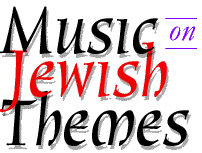![[photograph of Daniel Kazez]](images/dkphoto.jpg)

![[photograph of Jeruzalémská Synagogue]](images/concertsites/prague.jpg)
Some
composer biographies
Joachim Stutschewsky, Six
Israeli Melodies and
Frejlachs
Joachim Stutschewsky (1891-1982) was a composer, folklorist,
cellist, lecturer, writer, and proponent of Jewish music. Born
in the Ukraine to a family that had been klezmorim (Jewish folk
musicians) for several generations, Stutschewsky took up the
violin at the age of five, and switched to the cello at age eleven.
He moved to Zurich in 1914 and then Vienna in 1924, where he
founded the Association for the Development of Jewish Music.
He moved to Israel in 1938. Stutschewsky collected and edited
Hassidic melodies, and incorporated many of these in his compositions.
Julius Chajes, Israeli Dance
A resident of Vienna,
Tel-Aviv, and then Detroit, Julius Chajes (1910-1985) was the
son of a surgeon and a concert pianist. In Palestine (1934-36)
he conducted research on ancient Hebrew music. Chajes arrived
in the U.S. in 1937, and served as Music Director at the Jewish
Community Center in Detroit. He was chairman of Hashofar, a society
for the promotion of Jewish music.
Ernest Bloch, Prayer
(From Jewish
Life)
At the age of ten, Ernest Bloch (1880-1959) wrote a vow that
he would become a composer. Then, in ritual fashion, Bloch burned
the paper over a mound of stones positioned in the shape of an
altar. Born in Geneva, Switzerland, he worked for a time in the
family clock-making business. His earliest works incorporated
traditional Jewish tunes as sung by his father, who was the son
of Meyer Bloch, president of the Jewish community of Lengnau
(in the Swiss Canton of Aargau). After composing many of his
major Jewish-inspired works, including Schelomo (1916),
he moved permanently to the United States, founded the Cleveland
Institute of Music (1920), and later became director of the San
Francisco Conservatory (1925).
Harvey Gaul, A Yigdal from Yemen
American composer
and conductor Harvey Gaul (1881-1945) performed as organist in
his native New York, as well as in Cleveland and Pittsburgh.
His teachers included the French composer Vincent d’Indy.
He was the first music director of radio station KDKA and a music
critic for the Pittsburgh Post-Gazette. Most of his 500+ compositions
were published under pseudonyms.
David Popper, Wie einst in schöner’n
Tagen
Best known as a
master cellist and pedagogue, David Popper (1843-1913) was also
a prolific composer of very effective genre pieces for the cello.
He was born in Prague and died near Vienna. His technical works
form the basis of modern cello study. According to Popper’s
student and biographer Stephen De’ak, Popper’s wife
“was not able to escape the Nazi occupation of Austria,
and like millions of others of her faith she was captured by
the Gestapo, and sent to a concentration camp in Germany, where
she met her end in the gas chambers” (David Popper, 1980).
Mario Castelnuovo-Tedesco,
Chant hébraïque
A member of an
old Florentine family, Mario Castelnuovo-Tedesco (1895-1968)
studied music at the Cherubini Royal Institute of Music. His
discovery (in 1925) of a notebook of Jewish melodies in his grandfather’s
house led him to begin composing Jewish compositions: “The
discovery of this little notebook was one of the deepest emotions
of my life and became for me a precious heritage.” Soon
thereafter he became familiar with the sounds of synagogue cantillation
and Hebrew melodies. Racial laws forced Castelnuovo-Tedesco to
leave his native Italy. When anti-Semitism became rampant in
Italy, during that country’s alliance with Nazi Germany,
Castelnuovo-Tedesco fled to the U.S. (1939). He settled in Hollywood
where, like many other composers of his time, he composed film
music, in addition to his other works.
![]()
![]() Home
Home![]() International concerts
International concerts![]() Why Jewish music?
Why Jewish music?
![]() Some composer biographies
Some composer biographies![]() Recent
special programs
Recent
special programs
![]()
Daniel Kazez, Professor Emeritus of Music
Wittenberg University
Springfield, Ohio USA